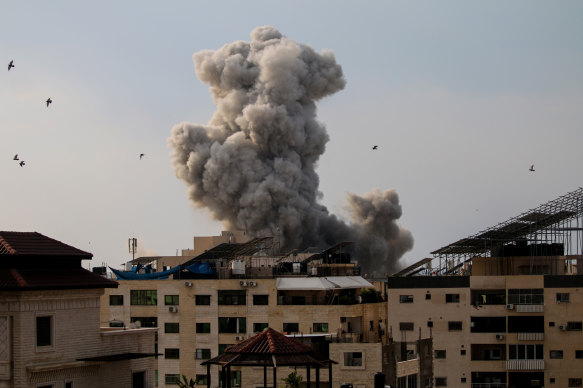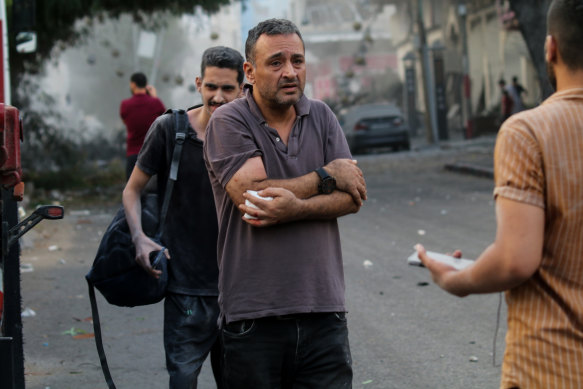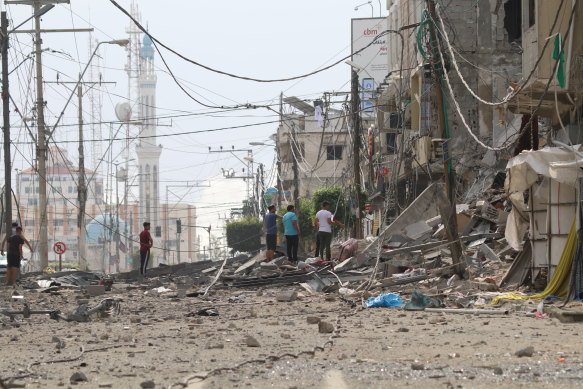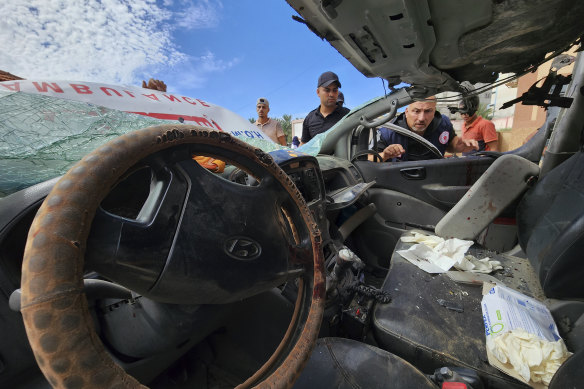This was published 1 year ago
‘National shock’: Israeli army mobilises, Hamas threatens hostages
By Lucy Cormack
Dubai: Hamas has threatened to execute one hostage for every Israeli attack on Gaza that lands without warning, marking an extraordinary escalation in tensions in the Middle East following the unprecedented incursions into Israel by the militant group on Saturday.
The threat of execution risks the lives of at least 130 hostages from around the world who were captured on Israeli soil during Hamas’ initial attacks.
Prime Minister Benjamin Netanyahu has appointed a special minister in charge of the hostage situation, vowing that Israel’s retaliation for the violence was “just the beginning”.

Smoke rises after an Israeli bombardment on Gaza City, Gaza.Credit: Getty
“What we will do to our enemies in the coming days will reverberate with them for generations,” Netanyahu said, likening Hamas to the Islamic State terrorist group.
“We have always known what Hamas is. Now the whole world knows. Hamas is ISIS.”
He said children had been bound and executed with their families, “young girls and boys shot in the back, executed, and other atrocities that I will not describe here.”
Netanyahu delivered the televised remarks on Tuesday morning (AEDT) following the hostage threat from Hamas’ armed wing spokesman Abu Ubaida in an audio recording released hours earlier.
Israeli Foreign Minister Eli Cohen warned Hamas against harming hostages, saying, “this war crime will not be forgiven.”
Gaza entered a new state of siege after Israel ordered immediate cuts to electricity, food and water supplies and escalated a relentless aerial bombardment that left the troubled enclave burning as the sun set on Monday.
Israel has amassed 100,000 Israeli troops plus tanks and armoured personnel carriers near the border with Gaza, stoking speculation of a full-scale ground invasion in retaliation for the attacks and hostage takings waged by the Hamas militant group.
Three days after the first Hamas assault, Israel has launched the largest army mobilisation in its history: on top of 170,000 active soldiers, the defence force has called up 300,000 reservists.

An injured man as a result of Israeli airstrikes in Gaza City, Gaza. Credit: Getty
At least one airline has added new flights to bring overseas reservists back to Israel to serve.
Late on Monday evening (AEDT) the Israeli military said it had re-established sovereign control of its southern towns where it had been battling Hamas gunmen. However, the desperate search for at least 130 hostages taken across the border to Gaza remains ongoing.
The death toll in Israel has surged to 900, of which the overwhelming majority are civilians. More than 680 Palestinians are confirmed dead and more than 3700 have been wounded since Israel launched its retaliatory aerial campaign.
During one three-hour period on Monday night, Israeli fighter jets made 130 air strikes on Gaza. Earlier, a US carrier strike group was ordered to sail to the Eastern Mediterranean to be ready to assist Israel after the attack by Hamas.
In an expansion of the conflict, Lebanese armed group Hezbollah fired a salvo of rockets into northern Israel. Two security sources told Reuters the move was a response to at least four of its members being killed in Israeli shelling on Lebanon.

Palestinian citizens inspect damage to their homes caused by Israeli airstrikes in Gaza.Credit: Getty
Speaking to mayors of southern towns overcome by the Hamas assault, Netanyahu vowed that Israel’s response would “change the Middle East”.
“I know you have been through terrible and difficult things. What Hamas will go through will be difficult and terrible … we have only just begun,” he said.
Late on Monday, Israeli Defence Minister Yoav Gallant ordered a “complete siege” of Gaza, saying authorities would cut all electricity and prevent food and fuel from entering the territory, which is home to more than two million people.
UN Secretary-General António Guterres said he was deeply distressed by the announcement of a complete seizure of the Gaza Strip.
“The humanitarian situation in Gaza was extremely dire before these hostilities,” he said. “Relief and entry of essential supplies into Gaza must be facilitated.”
Guterres said he recognised the “legitimate grievances of the Palestinian people” but said nothing could justify acts of terror.
“The killing, maiming and abduction of civilians. I reiterate my call to immediately cease these attacks and release all hostages.”
The US has begun delivering critically needed munitions and military equipment to Israel, the White House said Monday, as the Pentagon reviews its inventories to see what else can be sent quickly to boost its ally in the three-day-old war with Hamas.
John Kirby, a spokesman for the National Security Council, confirmed Monday evening that the first batch of military aid in the wake of the violent assault by Hamas militants is “making its way” to Israel.
University of Oxford Professor Eugene Rogan said the taking of hostages from Israel and bringing them back to Gaza was likely to impose limits on what Israel can do in retaliation.
“I think as horrible as the human shield concept is, Hamas anticipates that there will be global support for an Israeli response that will be extraordinarily violent for Palestinians – and this is their insurance policy,” said Rogan.
“How it plays out moving forward from here is anyone’s guess.”
Rogan, who is the director of the Middle East Centre at Oxford’s St Antony’s College, said the Hamas attack had revealed a failure at the level of the Israeli government that would drive Netanyahu and the cabinet to “extraordinary measures” to demonstrate their responsibility.
“This has been a national shock for Israelis,” he added.
Johns Hopkins University Professor of Political Science Adria Lawrence said the nature of the violence employed by Hamas, like kidnappings and executions against civilians and non-Israelis, made it less likely that outsiders would demand a restrained response.
“Hamas’s brutal acts likely remind Americans of the 9/11 attacks and the war on terror and render a strong counter-attack by Israel understandable,” she said.
“One thing to keep in mind is that brutal violence on either side does little to solve the long-term question of the status of Palestinians in the Gaza Strip, who have long been living in an untenable situation.”
How did we get here?
Hamas launched a surprise attack on Israel on Saturday local time, with barrages of rockets and cross border attacks, killing hundreds.
Israel in turn has killed hundreds Palestinians in airstrikes. Hamas now holds 130 Israelis hostage.
Tensions have been increasing between Israel and Hamas with rounds of rocket fire followed by Israeli airstrikes. The two sides clashed as recently as 2021.
However, there was no sign an attack of this scale and sophistication was pending this week. The ability of Hamas to circumvent Israel’s intelligence services to stage the attack has raised suspicion it had help from outside.
It also comes as plans for an Israel–Saudi Arabia diplomatic normalisation deal come closer to reality, which displeases Iran.
Meanwhile, hardline Islamists, such as those involved in Hamas, resist the rapprochement between Saudi Arabia, home to Muslim holy sites, with Israel.
Why it matters
The political order of the Middle East itself is in flux, unsettled by the rise of China and the transition away from fossil fuels among other things. A war that involves Israel fighting against forces with backing from Iran raises the risk of a larger conflict in the region.

Palestinian medics inspect a damaged Ambulance hit by an Israeli air strike inside Nasser Hospital in Khan Younis, southern Gaza Strip.Credit: AP
There are large diasporas of pro-Palestinian Arab communities, as well as pro-Israel Jews around the world, including in Australia. So the conflict between Hamas and Israel can shape and affect local politics.
The surprise attack suggests not just a failure of Israel’s intelligence community to prevent it, but raises questions about whether Hamas had outside help in planning and coordination to evade detection. This raises suspicions for Iran, which helps elevate the risks around this war.
Key players
Israel Formed in 1948 as a homeland for Jews, many fleeing persecution, Israel’s creation has brought it repeatedly into conflict with Palestinians, who claim the same land and with whom its Arab neighbours historically support.
Hamas A Palestinian Islamist militant group which operates from and controls the Gaza Strip, a 40km long parcel of land between Israel, Egypt and the Mediterranean Sea, home to more than 2 million. It is backed by Iran.
Palestinian territories Two regions of the former British Mandate for Palestine, namely: the West Bank (including East Jerusalem) and the Gaza Strip.
Hezbollah The Iran-backed Hezbollah militia fired artillery and rockets into territory Israel controls. Hezbollah was founded by Iran’s Revolutionary Guards to export its Islamic Revolution.
Turkey The country has historic links through the region and has offered to increase diplomatic effort for peace, at the same time requiring a two-state solution between Israel and the Palestinians.
Saudi Arabia The Kingdom is reportedly close to a landmark deal to recognise Israel diplomatically. However, the historic shift has been met with alarm by the Middle East regional competitor Iran.
Iran Tehran has long opposed Israel, threatened and funded terrorism and paramilitaries aimed at Israel. It sees Israel as an outpost of Western imperialism.
with Reuters, AP, Chris Zappone
Get a note directly from our foreign correspondents on what’s making headlines around the world. Sign up for the weekly What in the World newsletter here.